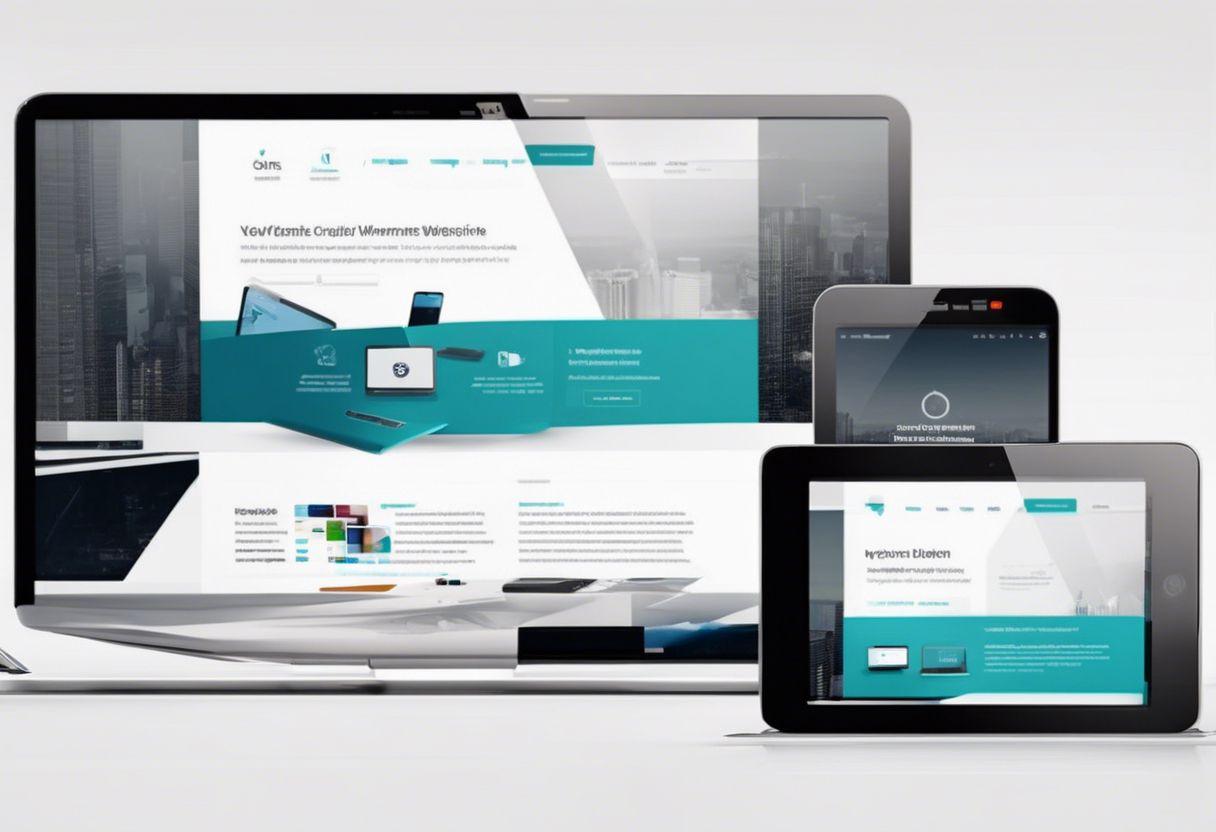Responsive Web Design: Techniques for Every Screen

Let’s talk about making websites work on all screens. Responsive web design is a way to make sure your site looks good whether someone is looking at it on a phone, tablet, or computer.
It moves around pictures and text so everything fits no matter the screen size.
Ethan Marcotte first showed us how to do this well by thinking about what users need and what their devices can do. The main parts of responsive design are fluid grids that change size, images that stretch or shrink, and special rules in CSS3 that respond to different screen sizes.
We have some cool tricks for making sites even better – like starting with mobile phones first and making sure things load fast so people don’t wait. There are also tools like Bootstrap which help you build these kinds of websites easily.
Best practices include designing for thumbs since we use our phones a lot, using phone features smartly, and not loading stuff until we really need it. And before you launch your website to the world, check everything works great on different devices.
Staying up-to-date with the latest tips is important because technology always changes! We’ll show you awesome examples of responsive designs that work great.
Ready to learn how? Keep reading as we share more on how responsive web design makes your online business shine!
Understanding Responsive Web Design

Understanding responsive web design is essential for ensuring that your website looks and functions well on any device. This includes understanding the concept of responsive design, the importance of adjusting to different screen resolutions, and utilizing core elements such as flexible grid layouts, images, and media queries in CSS3.
The Concept of Responsive Web Design

We all want our websites to look good on any device, be it a big desktop screen or a small phone. Responsive web design makes this possible. It’s like water taking the shape of whatever container you pour it into; websites adjust their layout and size to fit the screens they’re viewed on.
Think about how many different devices people use these days—phones, tablets, laptops, even smart TVs. We create websites that work well and look great on all these gadgets without needing separate versions for each one.
This means when someone checks out your site on their phone, they get just as good an experience as if they were sitting in front of a computer.
A website with responsive design shifts its content around so everything can be seen and used no matter what size the screen is. Big pictures shrink down, menus change into dropdowns or off-canvas slides—it’s all about making sure users have a smooth time finding what they need from your business online.
Plus, search engines love mobile-friendly sites and often rank them higher in searches!
Importance of Adjusting to Different Screen Resolutions

Responsive web design isn’t just a trend, it’s vital for making sure your website works on any device. Think about how many different screens people use every day — phones, tablets, laptops, and big TV screens.
Your website has to look good and be easy to use on all these screens. This is where adjusting to different screen resolutions comes in.
Let’s talk about why adapting to various screen sizes matters so much. First off, it helps everyone see your site the way you want them to. If someone visits your site on their phone and it looks messy or doesn’t work right, they might leave and not come back.
We aim for our websites to be friends with all devices: from tiny phones to huge TVs.
Another reason this is key is mobile compatibility. Lots of people surf the web on their phones now more than ever before. So if your site isn’t mobile-friendly, you’re missing out on a lot of potential visitors – that’s likely customers too! As small business owners like us know well, we need our websites ready for anyone who pops by online – whatever gadget they have in hand!
Adjusting layouts and content ensures everybody gets the information they need without hassle or confusion — making things better both for them and for you.
Core Elements of Responsive Design

Core elements of responsive design include flexible grid layouts, which allow content to adapt to different screen sizes, and flexible images and media that resize and reflow based on the viewing device.
Additionally, media queries in CSS3 enable designers to apply specific styles based on various parameters, such as screen width or orientation. These techniques are essential for creating a seamless user experience across different devices.
Flexible Grid Layouts

We all know that people use many different devices to look at websites. That’s why we use flexible grid layouts in responsive web design. This means our sites can change size and shape to fit any screen, from a big desktop monitor to a small phone screen.
We set up a grid based on percentages, not fixed sizes like pixels. So everything stretches or shrinks in a way that still looks good and works well.
Our grids are smart, too. They can move things around depending on the device someone is using. It’s like magic – text, pictures, even videos can find their best spot no matter where they are viewed.
And we don’t have to worry about making lots of versions for different screens either; one design does it all! This saves us time and makes sure our customers get the same great experience every time they visit our site.
Flexible Images and Media

After implementing flexible grid layouts, the next step in ensuring a fully responsive design is incorporating flexible images and media. These elements allow visual content to adapt seamlessly to different screen sizes, resolutions, and orientations.
Fluid images and scalable media are utilized to maintain high-quality display while dynamically adjusting within the layout. Media queries play a pivotal role in targeting specific styles for various devices, ensuring an optimal user experience across screens.
One fundamental aspect of flexible images lies in their adaptability without fixed size limitations, enabling them to flow harmoniously within the responsive layout. Similarly, scalable media such as videos also adjust proportionally based on available screen space.
Media Queries in CSS3

Now, let’s talk about media queries in CSS3. These are really important for responsive web design. With media queries, we can create different layouts based on the size of the browser window or screen.
If you’ve ever visited a website and noticed how it looks good no matter if you’re on your phone or computer, that’s thanks to these media queries.
CSS3 has added many new types of devices that can be targeted with media queries. We use them to adjust our layout depending on things like screen sizes, device characteristics, and even user preferences! By using HTML and CSS along with media queries, we can make sure our content looks great no matter what device someone is using.
Advanced Techniques and Strategies

When it comes to advanced techniques and strategies for responsive web design, adopting a mobile-first approach can greatly enhance the user experience. Designing specifically for touchscreens versus traditional cursors can also improve functionality and usability on various devices.
For further in-depth reading on these advanced concepts, explore additional literature and tutorials available on responsive web design.
A Mobile-First Approach

When we talk about a mobile-first approach, it means designing for the smallest screens first and then scaling up to larger ones. This strategy prioritizes creating an optimal experience for mobile users before considering desktop or tablet designs.
Embracing a mobile-first approach allows small business owners to cater directly to their growing mobile audience, ensuring that their websites are not just accessible but also user-friendly on smaller devices.
By adopting this technique, businesses can enhance their cross-device compatibility and adaptability while providing a seamless transition across various screen sizes.
Designing for Touchscreens vs. Cursors
When we talk about designing for touchscreens versus cursors, one crucial aspect to consider is user interaction. Touchscreens require designs that accommodate finger input, recognizing that fingers are larger than cursors.
This means ensuring that buttons and interactive elements have enough space for users to tap accurately. Additionally, understanding gesture recognition and multitouch technology can enhance the user experience on touch devices.
In contrast, when designing for cursors, we focus more on cursor navigation and interface design flexibility. This involves optimizing interfaces for precise clicking or hovering actions.
Conditional Loading for Performance Optimization
When considering the performance of our website across different screens, we look to employ advanced techniques like conditional loading. This strategy allows us to prioritize and optimize the loading of resources based on the user’s device, screen size, or network capabilities.
By dynamically loading essential content first and progressively enhancing with non-essential elements as needed, we ensure efficient resource management for a faster and smoother user experience.
Conditional loading is integral to responsive design performance optimization and speed enhancement. It enables us to adaptively load resources such as images or scripts based on screen responsiveness, thus significantly improving efficiency and speed without compromising functionality.
Tools and Resources for Responsive Design

Explore the wide range of responsive design frameworks, tools for image solutions, and workflow resources that can simplify the process of creating a seamless user experience across different devices.
Find out how these tools can optimize your web design for better performance and engage with our in-depth guide on responsive web design to enhance your digital presence.
Responsive Design Frameworks
Responsive design frameworks are essential tools for small business owners creating websites that adapt to various devices. These frameworks provide a solid foundation for building responsive websites with ease. By utilizing these frameworks, small businesses can ensure their websites look and function well across different screen sizes and resolutions.
- Adaptive Design: This type of framework allows your website to adapt its layout and design elements based on the user’s device, ensuring a consistent and optimized experience for all visitors.
- Fluid Grid Layout: Using fluid grid systems within the framework helps in creating flexible layouts that adjust proportionally based on the user’s screen size, thus maintaining visual coherence and usability across devices.
- Media Queries: Incorporating media queries into the framework enables the website to apply different styles based on specific conditions like screen resolution, width, height, orientation, or even color scheme preferences.
- Scalable Design: Frameworks that support scalable designs ensure that images and media elements resize proportionally to fit various screen sizes without losing quality or disrupting the overall user experience.
- Device Agnostic Approach: Opting for a framework with a device-agnostic approach ensures that your website functions seamlessly across a wide range of devices, regardless of their operating systems or hardware specifications.
- Progressive Enhancement: Utilizing frameworks supporting progressive enhancement allows your website to start with a solid foundation accessible from any device before gradually enhancing its appearance and functionality based on the capabilities of the accessing device.
- Cross-Browser Compatibility: A responsive design framework should prioritize compatibility across different web browsers to ensure consistent performance and appearance irrespective of the browser being used by site visitors.
Tools for Responsive Image Solutions
In the modern age, it’s essential to have tools that can scale images to fit common devices in responsive web design. One commonly used tool is ImgSizer.js, which creates different sized images from the original ones. Here’s a detailed list of tools for responsive image solutions:
- Responsive Image Breakpoint Generator: This tool helps in generating breakpoints for images based on various device resolutions and screen sizes.
- Adaptive Image Compression Tools: These tools intelligently compress images to maintain quality while reducing file size, ensuring faster loading times without compromising visual appeal.
- SVG (Scalable Vector Graphics) Optimizers: For vector-based graphics, using SVG optimizers reduces file sizes and ensures crisp, clear visuals on all devices.
- Picturefill: A polyfill that enables support for the picture element and associated media queries, allowing for better management of multiple image sources for different screen resolutions.
- Srcset Attribute Generators: Tools that assist in generating srcset attributes for responsive images, enabling browsers to choose the most appropriate image based on device characteristics.
- Retina Image Display Converters: These tools facilitate the creation of high-resolution versions of images specifically tailored for Retina displays while ensuring compatibility with standard resolution screens.
- Accessible Image Description Editors: Including alt text and accessible descriptions is crucial for inclusivity; these tools aid in creating accurate and effective descriptions for all images.
- Lazy Loading Plugins: Implementing lazy loading improves page loading speed by deferring non-essential image loading until they appear within the user’s viewport.
Workflow and Strategy Resources
After ensuring responsive image solutions, small business owners can benefit from employing effective workflow and strategy resources to enhance their website development. Here are some essential elements to consider:
- Lean UX Workflow: Implementing a streamlined user experience (UX) process can ensure that the website functions seamlessly across different devices, delivering a consistent and intuitive interface for users.
- Cross-Platform Design Principles: By following design principles that cater to multiple devices, such as visual hierarchy and adaptive layout, businesses can create websites that adapt well to various screen sizes and resolutions.
- Frontend Development Techniques: Employing scalable design approaches and CSS media queries in frontend development allows for the creation of adaptable and user-friendly sites that provide optimal viewing experiences across different devices.
Best Practices for Effective Responsive Design

Leveraging device hardware for enhanced features and designing for thumb interactions are essential best practices for effective responsive design. These practices prioritize user experience and ensure that the website is optimized for various devices.
Eliminating Friction in User Experience
In our quest for effective responsive design, eliminating user experience friction is crucial. This means creating a seamless interactionfor visitors to your website. By doing so, we improve user satisfaction and increase engagement on every device.
It’s about optimizing the mobile experience and ensuring smooth cross-device compatibility. When users encounter no resistance in navigating your site, they are more likely to stay longer, interact more, and ultimately convert better.
To achieve this goal of frictionless user experience, we focus on mobile optimization and website usability. Through enhanced interactions and conversion optimization strategies, we can provide an enjoyable browsing journey that leads to increased satisfaction and improved business performance.
Designing for Thumb Interactions
Now that we’ve focused on eliminating friction in user experience, let’s delve into the specifics of designing for thumb interactions. When it comes to small screens and mobile devices, users primarily interact through tapping with their fingers or thumbs.
This means that the design should prioritize ease of use with these inputs. Responsive web design aiming for optimal mobile UX must consider finger-friendly elements, ensuring that buttons, menus, and interactive components are large enough and well-spaced to accommodate comfortable tapping.
It’s important to keep in mind that this practice not only improves usability but also contributes to overall user satisfaction.
Our goal is smartphone usability optimization by making touch interactions intuitive and effortless. Leveraging fingerfriendly design enhances the user interface for mobile devices like smartphones, focusing on enhancing the overall mobile UI/UX experience.
Leveraging Device Hardware for Enhanced Features
In responsive web design, we can make the most of a device’s hardware to improve user experience. By tapping into the capabilities of different devices and platforms, we can ensure that our websites and applications work seamlessly across all screens.
This includes adapting to various screen sizes, orientations, and touch functionalities. Leveraging device hardware for enhanced features is essential for providing a smooth user interface, optimizing interactions for different devices, and ensuring cross-device functionality.
It also enables us to create designs that are not only visually appealing but also functionally efficient on any platform.
By leveraging device hardware in responsive design, we ensure that our users enjoy a consistent experience regardless of their chosen device. This approach allows us to optimize mobile performance effectively while taking advantage of each device’s unique capabilities.
Design Considerations for Various Devices

When designing for different devices, it’s important to consider fluid and adaptive layouts that can seamlessly adjust to various screen sizes. Additionally, pay attention to landscape orientation considerations and implement responsive typography for optimal viewing on all devices.
Fluid and Adaptive Layouts
Responsive web design involves creating designs that can adapt to different screen sizes and device types. When it comes to fluid layouts, they are designed to be flexible and flow smoothly within the given space, ensuring an optimal viewing experience across various devices.
On the other hand, adaptive layouts use fixed layout sizes based on breakpoints, offering more precise control over the design at specific screen sizes. Both techniques play a vital role in ensuring that your website looks great and functions well, regardless of the user’s device or screen size.
By understanding these concepts, small business owners can ensure their websites are accessible and engaging for all users.
Landscape Orientation Considerations
Considering landscape orientation is crucial for responsive web design. We need to ensure that the website looks good and functions well when users rotate their devices. This means providing a seamless experience whether the device is held in portrait or landscape mode.
Our goal should be user satisfaction regardless of how they hold their mobile devices.
To achieve this, we must create fluid and adaptive layouts that adjust smoothly to different screen sizes and orientations. Furthermore, we need to pay attention to responsive typography so that text remains readable and visually appealing in both orientations.
Responsive Typography
When we consider the diverse devices small business owners’ customers use, responsive typography becomes a pivotal aspect of web design. It involves choosing typefaces and arranging text to ensure readability and visual appeal on screens of varying sizes.
The font selection, text arrangement, and visual hierarchy play a crucial role in adapting content presentation to different screen sizes while maintaining optimal readability. We aim for an adaptive design that enhances user experience across devices, ensuring the legibility of content regardless of the device compatibility.
Considering the importance of responsive typography in reaching and engaging with your audience effectively, it’s essential to focus on practical benefits such as improved user experience and enhanced communication.
By implementing responsive typography strategies, small businesses can establish a consistent tone through their typefaces and ensure that their message is communicated clearly on all devices.
Performance Optimization Tips

Implementing lazy loading for non-essential media and optimizing responsive email newsletters can significantly improve website performance. Learn more about these techniques to enhance your site’s speed!
Lazy Loading of Non-Essential Media
We use lazy loading to make our website faster and save system resources. This technique delays loading non-essential media until a user needs it. Here are various ways small business owners can effectively implement lazy loading on their websites:
- Deferred loading: Delay the loading of non-essential media files to enhance user experience and optimize website loading times.
- Ondemand loading: Load heavy, non-important elements only when they become visible on the user’s screen, reducing the initial load time and improving website performance.
- Resource optimization: Optimize the loading of web page content, particularly images or other media files, for improved website performance.
- Page speed optimization: Improve page performance by delaying the loading of off-screen media files such as images and videos.
- Content prioritization: Prioritize essential content to load first, enhancing user experience and site performance.
- Efficient loading: Implement efficient methods to load heavy elements only when necessary while maintaining optimal site performance.
Implementing Responsive Email Newsletters
After considering performance optimization, we know that implementing responsive email newsletters is crucial for ensuring consistent user experience across various devices. Here are some key factors to consider:
- Cross-Device Compatibility: Design your email newsletter to adapt seamlessly to different screen sizes and resolutions, ensuring it looks great on both desktops and mobile devices.
- Mobile Optimization: Optimize the layout of your email newsletters for mobile viewing, prioritizing easy readability and clear call-to-action buttons on small screens.
- HTML/CSS Coding: Use responsive design techniques in the coding of your email templates to ensure they adjust dynamically to the display size of the recipient’s device.
- Image Optimization: Compress and optimize images within your emails to reduce data usage and ensure fast loading times, especially on mobile networks.
- Email Layout Consistency: Maintain a consistent layout and formatting across different devices, ensuring that your branding and message remain intact regardless of the device used for viewing.
Essential Steps for Launching a Successful Website

Ensure seamless user experience by testing your website on various devices, optimizing page load times, ensuring cross-browser compatibility, and implementing SEO best practices. To learn more about launching a successful website, check out our comprehensive guide on responsive web design techniques for every screen!
Pre-Launch Checklist for Responsive Web Design
Before launching your website, it’s crucial to ensure everything is in order. Here’s an 8-step pre-launch checklist to guarantee a successful and effective web launch for small businesses using responsive design.
- Check Mobile – Friendly Design
- Test Cross – Device Compatibility
- Review Website Functionality
- Optimize Design for Performance
- Ensure Site Accessibility
- Verify Design Readiness
- Publish Using Webflow Website Launch
- Conduct Final Quality Assurance
Showcase of Responsive Web Design

Showcasing examples of well-implemented responsive designs can provide inspiration and insight for small business owners looking to adapt their websites. From e-commerce sites to news outlets, seeing real-world examples can help demonstrate the effectiveness of responsive web design in action.
Examples of Well-Implemented Responsive Designs
Responsive designs are important for all screen sizes. Here are 11 examples that show how it’s done well. These sites offer exceptional user experiences and go beyond basic responsive design principles.
One great example is a clothing brand’s website. On desktop, the site showcases large images and detailed information, while on mobile, it simplifies to ensure a smooth experience.
Another well-implemented design is an online magazine which seamlessly adjusts its layout from wide screens to small ones without losing readability.
Further Reading and Resources

For further exploration of responsive web design, we encourage you to delve into additional literature and tutorials on the topic. There are numerous online resources available that can provide in-depth insights and practical tips for implementing effective responsive design across various devices.
Keep learning and adapting to stay ahead in the ever-evolving digital landscape.
Additional Literature and Tutorials on Responsive Web Design
We have found that there are many valuable resources for learning more about responsive web design. Here are some additional literature and tutorials that can provide further insight and guidance:
- Tutorials: Step-by-step guides to understanding and implementing responsive design principles in web development projects.
- Articles: In-depth discussions on the latest trends, techniques, and best practices in mobile-friendly design and user experience.
- Tools: Resources for utilizing CSS frameworks, frontend coding, fluid layouts, media queries, grid systems, and cross-browser compatibility.
- Accessibility Guides: Detailed materials on creating adaptive designs to ensure inclusivity across various devices and user needs.
- Web Development Trends and Innovations
Conclusion

In conclusion, responsive web design is a critical component of creating a seamless user experience across all devices. By understanding the core elements and best practices, small business owners can ensure their websites are accessible and engaging for everyone.
To continue learning about this topic, check out our further reading and resources section for additional literature and tutorials on responsive web design.
Summarizing the Importance of Responsive Design
Responsive design is crucial for every small business owner’s website because it ensures that their site looks and works great on all devices. Whether a customer visits the website on a smartphone, tablet, or desktop computer, responsive design guarantees that the layout adjusts to fit perfectly on any screen size.
This enables a seamless and user-friendly experience for all visitors. Moreover, with the increasing use of mobile devices to access websites, having a responsive design becomes even more essential as it can help in attracting and retaining customers.
The benefits are numerous – from improved user satisfaction to increased mobile traffic and easier web maintenance.
By embracing responsive design, businesses can offer their audience an adaptive layout that caters to different screen resolutionswhile maintaining an attractive and functional interface.
Encouraging Continuous Learning and Adaptation
To continue the journey of fostering responsive design, it’s crucial to embrace continuous learning and adaptation. This approach acknowledges that the digital landscape is constantly evolving, and as small business owners, being flexible and user-centric is key to providing dynamic and mobile-friendly experiences.
By understanding the importance of adaptability in web design, we can create fluid designs that seamlessly adjust across various devices for an optimal user experience.
Embracing continuous learning means staying updated on new techniques and tools while keeping the user experience at the forefront. It involves leveraging progressive enhancement strategies to ensure our websites are not only adaptable but also performant.
FAQs
1. What is responsive web design?
Responsive web design is an approach that makes web pages render well on a variety of devices and window or screen sizes.
2. Why is responsive web design important?
Responsive web design is important because it ensures that users have a good experience regardless of the device they are using, leading to higher engagement and satisfaction.
3. How do I make my website responsive?
To make your website responsive, you can use techniques like fluid grids, flexible images, and media queries to adapt the layout based on different screen sizes.
4. Do I need programming skills to implement responsive web design?
While some level of coding knowledge can be helpful, there are many tools and frameworks available that allow for easier implementation of responsive web design without extensive programming skills.
5. Are there any specific best practices for creating a responsive website?
Using mobile-first approach, optimizing images and content for faster load times, and testing the site across various devices are some best practices for creating a successful responsive website.


